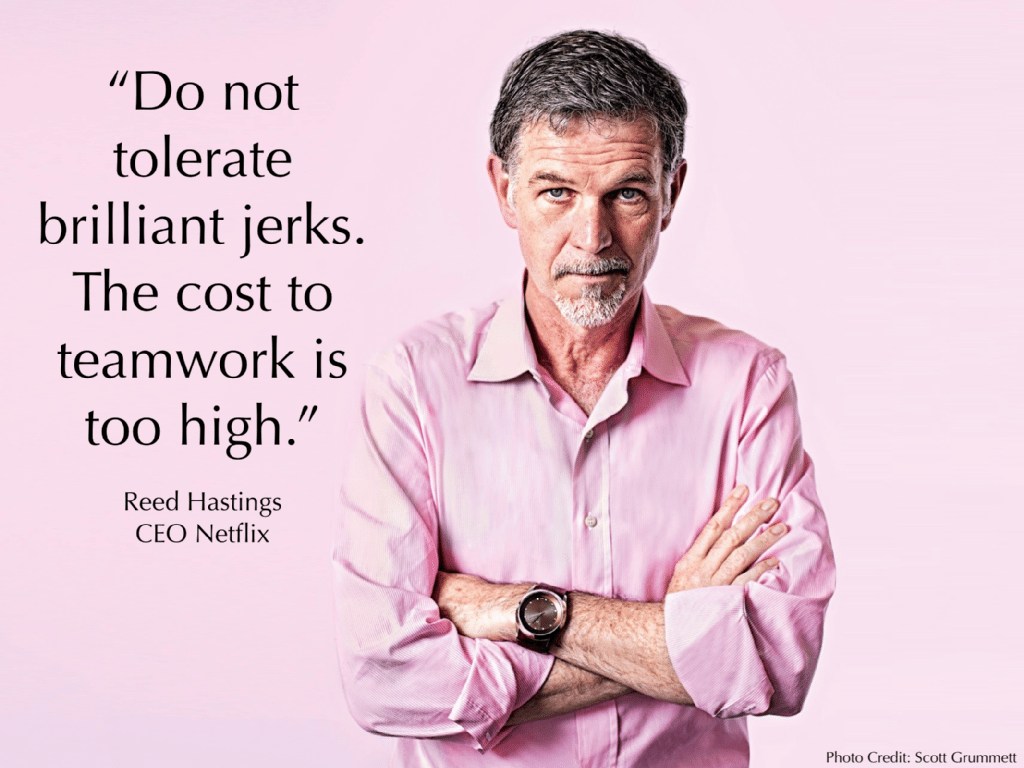Entrepreneurs
The Success of Reed Hastings

It has been understanding the value of consistent focus that has led to Reed Hastings’ success.
Reed Hastings’ estimated net worth is $940 Million.
After honing a laser like focus in his early years, Reed Hastings has gone on to become the founder and CEO of an entertainment company that defines an age. Netflix.
Reed Hastings’ Early Years
 After leaving Bowdoin College Hastings decided to join the Peace Corps. He describes a feeling of adventure and a desire to serve as his motivation. This quest for service led him to teach mathematics at a school in Swaziland for two years between 1983 and 1985. It was during his time in the Peace Corps that Hastings discovered and developed his entrepreneurial spirit. He believed that once you have made your way across Africa with ten dollars to your name, starting a business didn’t seem like such a daunting task.
After leaving Bowdoin College Hastings decided to join the Peace Corps. He describes a feeling of adventure and a desire to serve as his motivation. This quest for service led him to teach mathematics at a school in Swaziland for two years between 1983 and 1985. It was during his time in the Peace Corps that Hastings discovered and developed his entrepreneurial spirit. He believed that once you have made your way across Africa with ten dollars to your name, starting a business didn’t seem like such a daunting task.
On his return from the Peace Corps, Hastings went to Stanford University where he graduated with a Master’s Degree in Computer Science in 1988.
Reed’s First Company
 In 1991 Hastings left his first job at Adaptive Technology to start his first company Pure Software, a company that produced troubleshooting software. As the company began to grow faster and faster Hastings found running the business very challenging. This came as a result of a lack of managerial experience. He was in over his head and didn’t know what to do, even trying to fire himself twice but his board wouldn’t allow it. As his confidence decreased his desire to ‘jump ship’ grew but his board declined and he eventually learned the ropes of being an effective CEO. The company was good at what it did, with revenue doubling every year but Hastings highlights his transformation from engineer to CEO as occurring when Morgan Stanley took the company public in 1995.
In 1991 Hastings left his first job at Adaptive Technology to start his first company Pure Software, a company that produced troubleshooting software. As the company began to grow faster and faster Hastings found running the business very challenging. This came as a result of a lack of managerial experience. He was in over his head and didn’t know what to do, even trying to fire himself twice but his board wouldn’t allow it. As his confidence decreased his desire to ‘jump ship’ grew but his board declined and he eventually learned the ropes of being an effective CEO. The company was good at what it did, with revenue doubling every year but Hastings highlights his transformation from engineer to CEO as occurring when Morgan Stanley took the company public in 1995.
Pure Software merged with Atria Software in 1996 and there were integration issues between the two companies with Hastings deciding to leave his new position of ‘Chief Technical Officer’ in 1997. It was at this point he decided to spend two years thinking about avoiding the same types of problems during his next startup.
“I’ve worked very hard, but my life’s always been fun.” – Reed Hastings
The Birth of Netflix
 In 1997 Reed Hastings Co-Founded Netflix along with Marc Randolph. Netflix began life as a fixed rate film rental by mail service to customers in the USA. Through its Headquarters in California Netflix has built a following of 44 Million subscribers.
In 1997 Reed Hastings Co-Founded Netflix along with Marc Randolph. Netflix began life as a fixed rate film rental by mail service to customers in the USA. Through its Headquarters in California Netflix has built a following of 44 Million subscribers.
Hastings describes having the idea for Netflix when he had a large late fee for a film that he had rented. He owed the store $40 and he didn’t want to tell his wife about it and he couldn’t believe that he was was going to be dishonest to his wife over a silly late fee. That same day Hastings had an idea when he was at the gym. He realized that gym’s had a much better business model because you could pay your monthly fee and work out however many times you pleased.
Hastings accepts that it may seem obvious to have unlimited due dates and no late fees now but at the time they had no idea whether or not customers would create and use an online queue.
A New Business Culture
 The challenges that Hastings faced during the growth of Pure Software led him to be very careful when developing Netflix. He wanted to build a company that would grow rapidly to become an entertainment juggernaut but he also wanted to build a company that did this whilst maintaining its entrepreneurial spirit.
The challenges that Hastings faced during the growth of Pure Software led him to be very careful when developing Netflix. He wanted to build a company that would grow rapidly to become an entertainment juggernaut but he also wanted to build a company that did this whilst maintaining its entrepreneurial spirit.
This became a reality and as Netflix grew, the company began to get recognised for its new management strategies as a result of what Hastings calls a ‘Freedom and Responsibility’ culture. Netflix is known for paying salaries that are much higher than normal so as to attract the very best employees. This is coupled with the fact that employees can choose how much of their remuneration they want in cash or stock.
Hastings doesn’t even have a set office space because he likes to move around headquarters meeting different people, finding spare tables when he needs to sit down and deal with personal emails. A further testament to his desire to be a part of positive business culture.
“Most entrepreneurial ideas will sound crazy, stupid and uneconomic, and then they’ll turn out to be right.” – Reed Hastings
The Present Day
The structure, functionality, people and overall reach of Reed Hastings’ Netflix is truly remarkable. With its 44 million subscribers watching more than 1 billion hours a month on over 1,000 different devices Hastings and Netflix has to ensure that this demand is met. They do this through custom video servers that are placed all around the globe. As soon as a subscriber clicks to stream a movie, Netflix calculates (in a fraction of a second) which server is the closest to the customer, it then chooses from dozens of versions of the video file that is best suited to that customers device.
It is this split second, tailored service that Hastings and Netflix continue to focus on with Hastings believing that we are amidst a revolution (that is becoming inevitable) where every television will have WiFi and Netflix built in as standard.
Conclusion
Reed Hastings is an absolute master of learning from his mistakes, focus and business culture. We can all learn from how Hastings took his time starting a new company before he had evaluated the challenges he had in his previous one.
No matter what the future holds for the inspiring, proactive Reed Hastings one thing is for sure, he will be focused!
We can learn from this focus so we can turn our own visions into reality in the same way that Reed Hastings has built Netflix.
Reed Hastings Picture Quote

Change Your Mindset
The Silent Skill That Makes People Respect You Instantly
What truly earns respect and why most people go about it the wrong way

Everybody craves respect but not everyone earns it. Some people believe that a title, years of experience, or a position of authority automatically entitles them to respect. (more…)
Entrepreneurs
The Essential Skills Every Entrepreneur Needs In 2026
Success in the digital age isn’t about luck. It’s about mastering the skills that separate dreamers from doers.

When I was 22 years old, I started my first side hustle as a ghostwriter. (more…)
Business
The Hidden Money Pit in Your Operations (and How to Use It)
See how smart asset management software is quietly saving businesses thousands in wasted time, stock, and maintenance.

Trimming unnecessary expenses and minimizing resources is a general practice in running a business effectively. Asset management software can help you achieve those goals. (more…)
Business
Thinking of Buying A Business? These 6 Sectors Quietly Produce the Best Deals
Before you buy your next venture, check out the sectors where successful businesses are changing hands every day.

All entrepreneurs have a desire to be the masters behind a successful venture. Buying an established business is a great choice for many. This provides instant access to an established market with existing infrastructure and clients. (more…)
-

 Change Your Mindset4 weeks ago
Change Your Mindset4 weeks agoThe One Leadership Habit That Separates the Great From the Forgettable
-

 Personal Development3 weeks ago
Personal Development3 weeks agoThis Silent Habit Might Be Sabotaging Your Career
-

 Business3 weeks ago
Business3 weeks agoWhy Your E-Commerce Fulfilment Is Probably Broken (And How to Fix It)
-

 Shift Your Mindset2 weeks ago
Shift Your Mindset2 weeks ago11 E’s That Define Every Great Leader And Why Most People Miss Them
-

 Did You Know2 weeks ago
Did You Know2 weeks agoThe Success Patterns You Inherited (And Didn’t Notice)
-

 Business2 weeks ago
Business2 weeks agoThe Hidden Money Pit in Your Operations (and How to Use It)
-

 Entrepreneurs1 week ago
Entrepreneurs1 week agoThe Essential Skills Every Entrepreneur Needs In 2026
-

 Change Your Mindset6 days ago
Change Your Mindset6 days agoHow to Turn Your Mind Into Your Greatest Asset (Instead of Your Enemy)

























